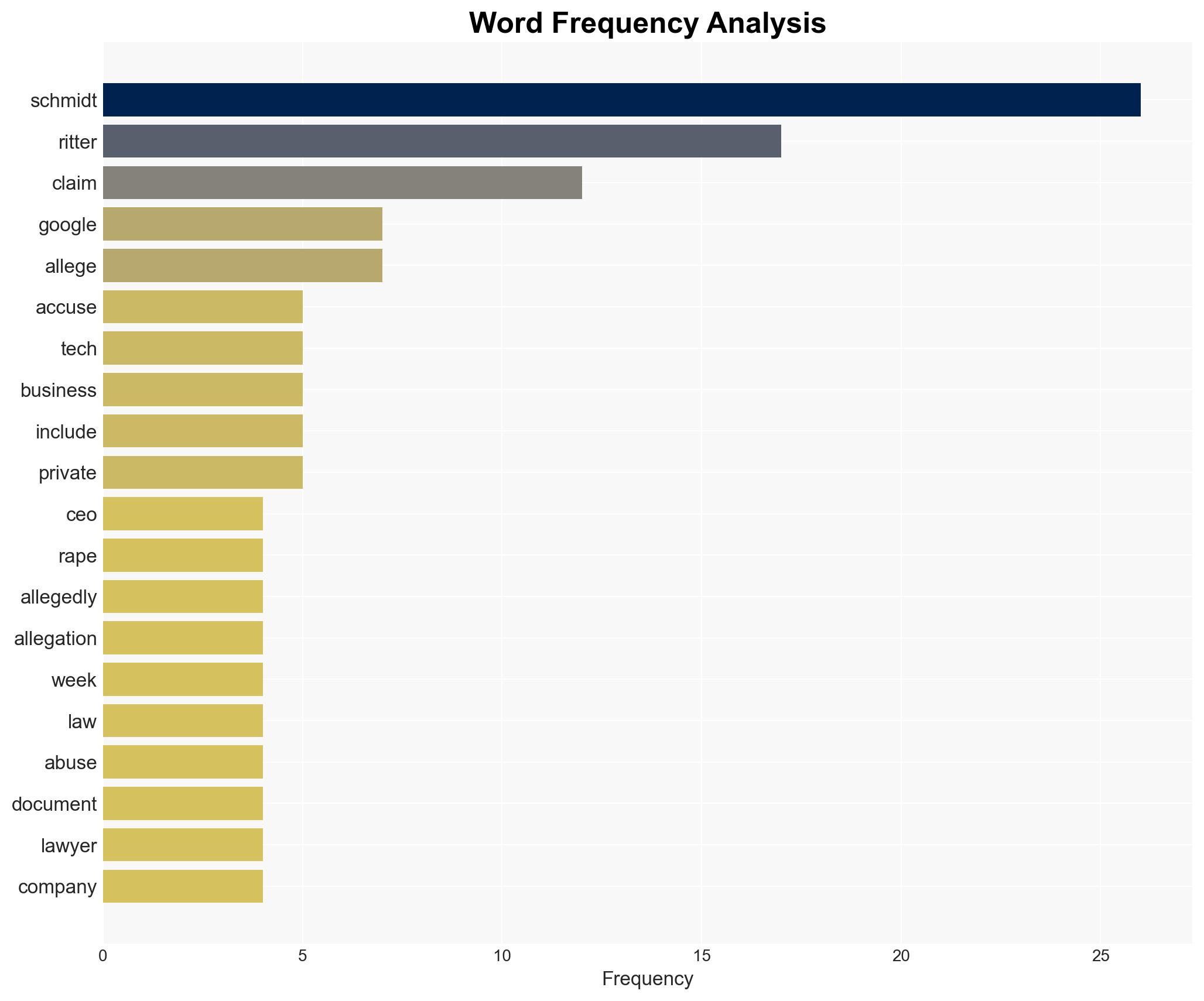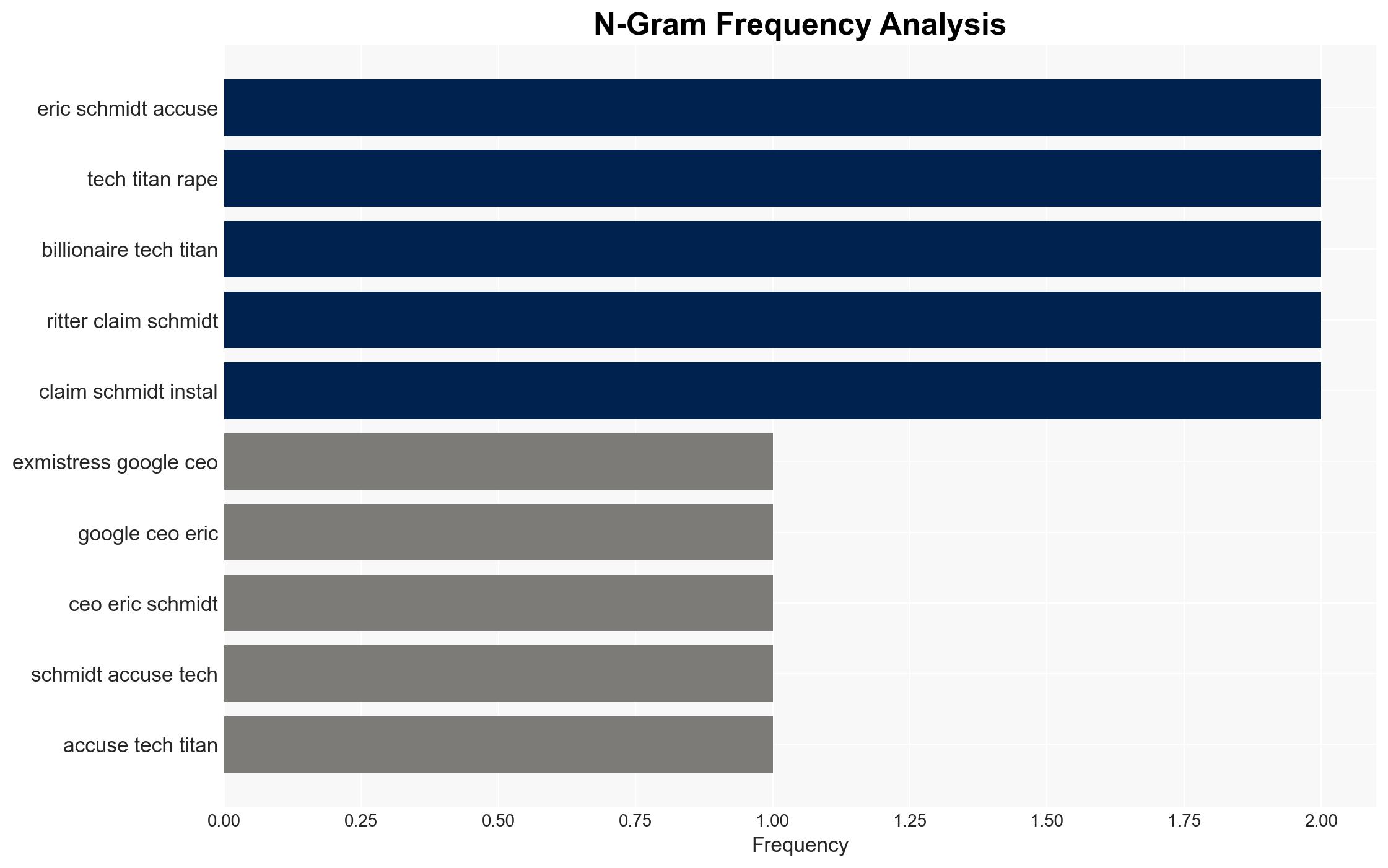Former Google CEO Eric Schmidt faces serious allegations of rape and invasive surveillance from ex-mistress.
Published on: 2025-11-26
AI-powered OSINT brief from verified open sources. Automated NLP signal extraction with human verification. See our Methodology and Why WorldWideWatchers.
Intelligence Report: Ex-mistress of former Google CEO Eric Schmidt accuses tech titan of rape creepy surveillance court docs
1. BLUF (Bottom Line Up Front)
The allegations against Eric Schmidt, former Google CEO, by Michelle Ritter, a tech entrepreneur, involve serious accusations of sexual assault, surveillance, and harassment. These claims, if substantiated, could have significant reputational and legal implications for Schmidt and potentially impact Google’s public image. The most likely hypothesis is that this is a complex legal and personal dispute with elements of truth on both sides. Overall confidence in this assessment is moderate, given the lack of corroborating evidence and the high-profile nature of the individuals involved.
2. Competing Hypotheses
- Hypothesis A: The allegations by Michelle Ritter are largely accurate and reflect a pattern of abusive behavior by Eric Schmidt. Supporting evidence includes detailed claims of physical and digital surveillance, as well as specific incidents of alleged assault. Contradicting evidence includes Schmidt’s legal team’s denial and potential lack of corroborative evidence.
- Hypothesis B: The allegations are exaggerated or fabricated as part of a broader legal and personal dispute. Supporting evidence includes the context of a “bitter legal spat” and the involvement of high-profile legal representation, suggesting a strategic legal battle. Contradicting evidence includes the specificity and consistency of Ritter’s claims.
- Assessment: Hypothesis B is currently better supported due to the absence of independent verification of the allegations and the potential for strategic legal maneuvering. Key indicators that could shift this judgment include the emergence of corroborative evidence or credible witness testimonies.
3. Key Assumptions and Red Flags
- Assumptions: The legal system will impartially evaluate the evidence; media reports are based on accurate court filings; both parties have incentives to protect their reputations.
- Information Gaps: Lack of access to court documents and evidence; absence of third-party verification of claims; unclear motivations behind the legal actions.
- Bias & Deception Risks: Potential bias in media reporting; strategic legal positioning by both parties; possible manipulation of public perception through selective information release.
4. Implications and Strategic Risks
This development could influence public perceptions of tech industry leaders and impact corporate governance standards. It may also affect Google’s reputation and stakeholder confidence.
- Political / Geopolitical: Potential scrutiny of tech industry practices and leadership ethics; could influence regulatory actions.
- Security / Counter-Terrorism: Minimal direct impact; however, increased focus on digital privacy and surveillance practices.
- Cyber / Information Space: Highlights risks of digital surveillance and privacy violations; may lead to increased advocacy for stronger cybersecurity measures.
- Economic / Social: Potential impact on investor confidence in tech firms; could influence social movements advocating for accountability in corporate leadership.
5. Recommendations and Outlook
- Immediate Actions (0–30 days): Monitor legal proceedings for new evidence; assess potential impacts on Google’s operations and public image.
- Medium-Term Posture (1–12 months): Develop strategies for crisis communication and reputation management; strengthen corporate governance and ethical standards.
- Scenario Outlook:
- Best: Allegations are resolved with minimal impact on involved parties’ reputations.
- Worst: Substantiated claims lead to significant legal and reputational damage.
- Most-Likely: Prolonged legal battle with mixed outcomes, affecting public perceptions but limited operational impact.
6. Key Individuals and Entities
- Eric Schmidt – Former Google CEO
- Michelle Ritter – Tech Entrepreneur
- Google – Technology Company
- Patricia Glaser – Lawyer representing Eric Schmidt
- Skip Miller – Lawyer representing Michelle Ritter
7. Thematic Tags
Structured Analytic Techniques Applied
- Adversarial Threat Simulation: Model and simulate actions of cyber adversaries to anticipate vulnerabilities and improve resilience.
- Indicators Development: Detect and monitor behavioral or technical anomalies across systems for early threat detection.
- Bayesian Scenario Modeling: Quantify uncertainty and predict cyberattack pathways using probabilistic inference.
- Network Influence Mapping: Map influence relationships to assess actor impact.
- Narrative Pattern Analysis: Deconstruct and track propaganda or influence narratives.
Explore more:
Cybersecurity Briefs ·
Daily Summary ·
Support us





